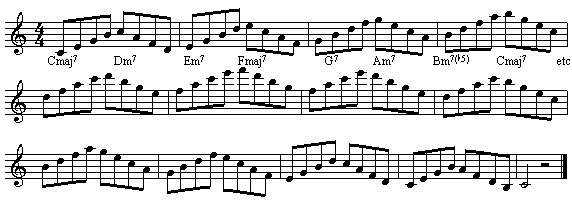Technical exercises help to form the foundation of a good technique, particularly a jazz technique. The ability to play scales and arpeggios of all types, in all keys, with fluency and precision is fundamental if you want to become an accomplished jazz player ... and that's just the easy part. You then have to be able to use them logically and musically.
Of course, a good jazz solo is comprised of much more than just technique but let's face it, Charlie Parker, Adderley, Coltrane etc, etc, wouldn't have got far without it! Even those notable individuals were not capable of 100% invention and inspiration. A fair percentage of any solo contains purely technical content, as a medium in which musical ideas are set. Technique provides a link between ideas and also helps you to express your ideas!
If you're serious about improving your jazz technique, then any exercise that you practise must be played by ear and in all keys. This is essential in order to bind your fingers to the mental conception of what you're playing.
One of the most common chord progressions in jazz and many other music forms is the II/ V/ I.
A thorough mastery of this progression (and the simpler II/V), with as many variations as you can think of, in all keys, will provide you with a very sound basis on which to build your technique.
Needless to say, acquiring the ability to do this requires lots of practise, but if you are serious about becoming a fluent improviser then such practise will be well rewarded.
For a fuller explanation of chord progressions and how to practise them, a course of lessons is recommended.
The following are a few random examples of technique building exercises, but endless variations are possible, so try making up some of your own. Once you've got the basic pattern, forget looking at the written notes, let your ear take over!
1 Basic Arpeggios Exercises
2 Chromatic Exercises
3 Diminished Scale Exercises
4 Exercises in fourths

1. Basic Arpeggio Exercises
Exercise (a) Diatonic Arpeggios - A useful starting exercise in which all notes are common to the home key. Play this in all keys and you will have covered many of the common arpeggios!
. Start a semi-tone higher each time, adapting to suit the range of the instrument.

Exercise (b) Descending/Ascending Minor 7ths - Start on top F and continue to low Bb,
Then repeat, starting on top E.

Exercise (c) Minor 7th to Diminished/Dominant 7b9 - Continue to low Bb.

Exercise (d) Minor 7th to Dominant 7b9 - Continue down, then repeat, starting on top E

Back to menu
2. Chromatic Exercises
Exercise (a) - Start on top D, then continue to low Bb

Exercise (b) - Start on top F and continue to low B

Exercise (b) - Start on top E, to low B. Repeat, starting on top Eb, then repeat starting on top D

Back to menu
3 Diminished Scale Exercises
Exercise (a) - Continue to top F. Repeat, starting first on Eb then E.

Exercise (b) - Continue down, then repeat from top C#, then C.

Exercise (c) - Continue down, then repeat from top C#, then C.

Back to menu
4. Exercises in Fourths
Exercise (a) - Continue up, then repeat, starting on low B.

Exercise (b) - Continue down, then repeat from top A, then Ab.

Exercise (c) - Continue up, then repeat from low F, then F#.

|